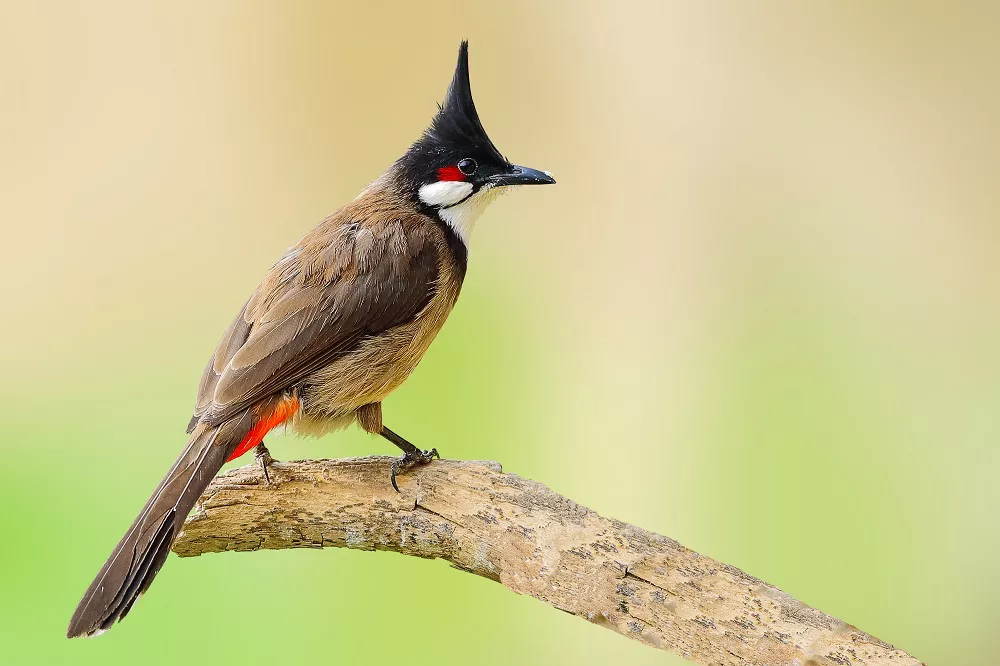The red-whiskered bulbul (Pycnonotus jocosus), or crested bulb, is a passerine bird native to Asia. It is a member of the bulbul family. It is a resident frugivore found mainly in tropical Asia. The red whiskered bulbul is a small bird , body length 17-21 cm.
What does red whiskered bulbul look like
The red-whiskered bulbul is black from the forehead to the top of the head, with a towering black crest on the top of the head. There is a dark red feather tuft below and behind the eyes, forming a red spot; the ear feathers and cheeks are white, closely attached to the red spot. The rest of the upper body, such as the back neck, the back to the upper coverts of the tail, are brown or earthy brown, and some specimens have brownish red feather edges. Tail dark brown or dark brown, except for the central 1-2 pairs of tail feathers, the rest of the tail feathers have white end spots, and the white spots on the outer tail feathers expand outward until the entire end. The coverts of the two wings are the same color as the back, the flight feathers are dark brown or dark brown, and the outer flaps are slightly decorated with khaki or light khaki. The cheeks and throat are white, and there is a thin black line between the white cheeks, extending from the base of the mouth along the white spots on the cheeks to the back of the ear feathers. The rest of the underparts are white or nearly white, the flanks are light brown or light smoky brown, and there is a wide dark brown or black horizontal band on both sides of the chest, extending from the lower neck to the middle of the chest through the chest side, and gradually narrows. Finally, it is interrupted in the center of the chest, forming an incomplete chest belt, and the undertail coverts are bright red or orange red.
The red-whiskered bulbul’s iris is brown, brown, brownish red or dark brown, and its bill and feet are black.
Red whiskered bulbul habitat
The red-whiskered bulbul mainly inhabits forests such as rain forests, monsoon forests, and evergreen broad-leaved forests in low mountains and hilly areas below 1,500 meters above sea level. It is also found in open areas such as forest edges, roadsides, streams, and farmland Shrubs and savannah slopes, sometimes even in bamboo forests, trees or bushes near courtyards and villages.
Red whiskered bulbul living habit
The red-whiskered bulbul is a resident bird. Lively, often in small groups of more than 10, sometimes in large groups of 20-30, and sometimes mixed with Red-vented bulbul and Brown-breasted bulbul. Lives and forages in the canopy of trees or shrubs most of the day. It is good at chirping, and the chirping sound is light and pleasant. Usually while jumping and looking for food, they sing.
Red whiskered bulbul diet
It is omnivorous, but mainly eats plant food. It often eats tree and shrub seeds, fruits, flowers and grass seeds, especially the fruits of trees and shrubs such as banyan trees, plums, heather, and indigo. Animal food is mainly insects and insect larvae of Coleoptera, Lepidoptera, Orthoptera and Hymenoptera.
Distribution range of red-whiskered bulbul
Distributed in China, Nepal, Sikkim, Bhutan, Bangladesh, India, Myanmar, Thailand, Vietnam, Laos and other places.
Mode of reproduction
The red-whiskered bulbul’s breeding season is from April to August, during which it is very active. It often stands on the treetops and sings loudly, or the male and female birds chase, dance and play with each other among the treetops and flowers. It usually nests on low trees such as bushes, bamboo bushes and fruit trees. The nests are mostly placed between the branches of bushes or bamboo bushes, and nests are also seen in banana forests and banana leaf stalks. The nest is made of thin dead branches, withered grass, leaves and other materials, and is lined with soft materials such as thin withered grass stems, grass roots, animal hair, and bird feathers. The nest is cup-shaped, 7-8 cm in diameter, 7-15 cm high, 4-6 cm deep, and 0.8-2 m above the ground. Each clutch lays 2-4 eggs, mostly 3 eggs. Eggs are pink, covered with dark red and lavender spots, especially conspicuous at the blunt end, often densely forming a dark purple-red ring at the blunt end. Egg size is 20-24 mm x 15-18 mm. The incubation period is 12-14 days.


 Facebook
Facebook  Instagram
Instagram  Youtube
Youtube 